5 Cell Biology and Molecular Genetics
Michelle Field

Cell Biology and Molecular Genetics
When Darwin developed his theory, there were two main things that he did not know:
1) how variation is produced, and
2) how traits are passed from one generation to the next.
In the decades since On the Origin of Species was published, subsequent generations of biologists, natural scientists, geneticists, paleoanthropologists, and others., have conducted research that has refined our knowledge about evolution. We now can address the things that Darwin did not know. Cell biology and genetics explain the production of variation and how traits are inherited.
Cell biology
All living organisms are made of cells. Some organisms are single-celled and spend their life made of just one cell and some organisms, like humans, are multi-cellular (have many cells).
Here are some basic points to remember about cells:
- cells are the structural and functional units of all living things
- all cells come from preexisting cells
- cells contain hereditary information (which is passed from “parent” cells to “daughter” cells during cell division).
Cell function
Cells are often called “the building blocks of life”. Not only are all living things made of cells (the ‘building block’ part), they also are living functional units themselves.
This is because cells do the following:
- obtain nutrients and other molecules through the cellular membrane (or cell wall) and convert that to biologically useful energy and useful molecules for building new cells (such as proteins and nucleic acids)
- make more cells (reproduction).
Types of cells
There are two types of cells: prokaryotic and eukaryotic.
Prokaryotes include bacteria and blue-green algae. These are single-celled organisms in which the genetic material is not distinctly separated from the other components of the cell. Eukaryotes include everyone else. These can be single-celled, but are more often multi-celled organisms in which the genetic material is separated from all of the other cellular components (by something called the nucleus).
Because our focus is on humans, the rest of our discussion will center on eukaryotes and eukaryotic cells.
Animal Cell structure
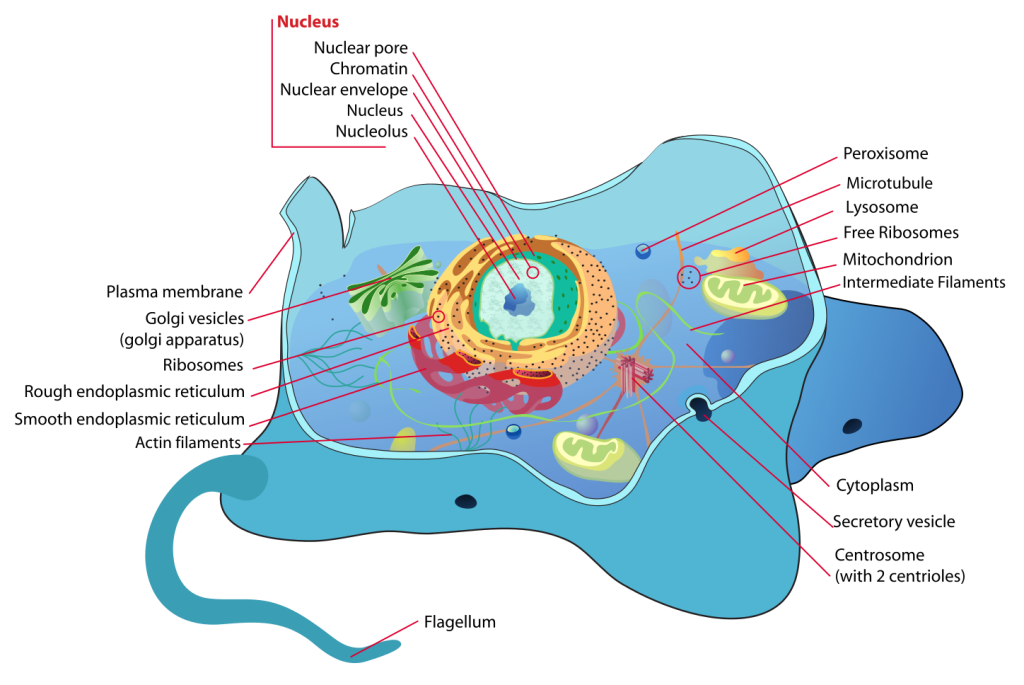
Each animal cell consists of a selectively permeable membrane (plants have cell walls) which contains the cytoplasm. Organelles are like “little organs” within the cytoplasm, each performing a different vital cellular function. These are some of the more important (to us) organelles.
Mitochondria: These are the “powerhouses” of the cell, responsible for production of the energy-rich molecule, ATP (adenine triphosphate), which powers the activities of the cell. Each cell has hundreds to thousands of mitochondria. Mitochondria have their own DNA, known as mitochondrial DNA (mtDNA), which is different from nuclear DNA (see below). Mitochondrial DNA has become an important tool in evolutionary research.
Endoplasmic reticulum: This is a transport network for molecules that have specific destinations or require certain modifications. It comes in two types: smooth and rough. Rough endoplasmic reticulum has ribosomes (see below) on the surface.
Golgi apparatus: Processes and packages large molecules such as proteins and lipids (fats) that are produced by the cell.
Lysosomes: Breaks down non-usable organelles, food, viruses, and bacteria using enzymes.
Ribosomes: Constructed of RNA and protein, ribosomes are the site of protein synthesis in the cell
Nucleus: This is where you’ll find the hereditary material, DNA (deoxyribonucleic acid) and RNA (ribonucleic acid).
Explore the cell!!
In this interactive exercise, you can identify the parts of a typical animal cell and review the functions of the various organelles.
Deoxyribonucleic Acid
DNA structure

DNA (deoxyribonucleic acid) is the genetic blueprint of the cell. The structure of DNA is what’s known as a “double helix”, which looks much like a twisted ladder.

The basic unit of DNA is a molecule called a nucleotide. Nucleotides are made of a sugar (deoxyribonucleic acid), a phosphate group, and a nitrogenous base. There are 4 different types of nucleotides, depending on what type of nitrogenous base they have.
-
-
-
- adenine (A)
- thymine (T)
- cytosine (C)
- guanine (G)
-
-
These are separated into 2 groups:
- purines: adenine and guanine
- pyrimidines: cytosine and thymine
On the DNA “rungs”, the bases must go in pairs: adenine (A) always bonds with thymine (T) and cytosine (C) with guanine (G). So, for base-pairs remember it’s always A+T and C+G! (That rule is sometimes called “The base-pair rule”.) If you want to explore further, check out what the Human Genome Project has learned about the human DNA sequence
RNA structure
RNA (ribonucleic acid) has a very similar structure to DNA, except that it’s single-stranded, has a different sugar (ribonucleic acid, rather than deoxyribonucleic acid), and does not contain thymine (T). Instead, it contains uracil (U), which like thymine, bonds with adenine (A). So, in this case, the base-pair rule is A+U and C+G.
DNA function
For our purposes, we will concern ourselves with two of DNA’s functions: replication and protein synthesis.
DNA replication
In this case, the goal is to replicate a DNA double helix to produce more DNA. DNA replication occurs in the nucleus of the cell.
The basic steps of DNA replication are:
- The DNA is “unzipped” into two single strands.
- Each unzipped strand acts as a template for reproduction of the complimentary strand.
- The product is two copies of the original DNA, each containing one strand from the original DNA and one strand that has been added on (the complementary strand).
Here’s a slightly more thorough illustration of the process: DNA replication – simple.
And for those who are really curious about the details of the process: DNA replication – complex.
And for those who are looking for a little fun with their DNA replication: DNA – the double helix game
Important note: The important thing to remember about DNA replication is that when the complimentary strand is created, sometimes accidents or mistakes happen. For example, a G gets matched up with a T instead of the proper A. This is where some of the variation in hereditary information comes from.
Protein Synthesis
Proteins are the most common large molecules in cells. Bones, muscles, and red blood cells (among lots of other body parts) are made mostly of proteins. Therefore, the production of proteins is obviously a very important process in the body.
Proteins are made of smaller units called amino acids. There are 20 different amino acids, 9 of which are “essential amino acids”, which means that they must be consumed through the diet, rather than being synthesized by the body. The sequence of amino acids in a protein determines its structure and function.
The base pair sequence of the DNA molecule is known as the genetic code. The genetic code consists of 3-base sequences called codons (remember our friends A, T, G, and C — the nitrogenous bases? That’s what we’re talking about here). Each codon either codes for an amino acid, or signals that the protein chain is starting (an initiation codon) or stopping (a termination codon). The table on the right shows which codons code for which amino acids.
Each DNA molecule contains the information to make up many different proteins. A portion of a DNA molecule responsible for making up a single protein (or sometimes just part of a protein, called a polypeptide) is a gene. Therefore, each DNA molecule consists of many genes, that code for many proteins.
Protein synthesis has two basic steps: (1) transcription and (2) translation.
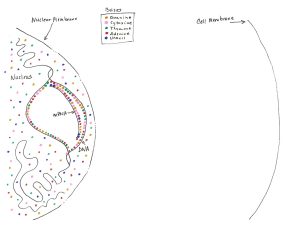
Transcription
1) The gene (DNA) is copied onto RNA. The RNA copy of the gene is called the messenger RNA (or mRNA).
2) The mRNA leaves the nucleus and goes to the rough endoplasmic reticulum. (Remember this organelle from the cell structure section above?)
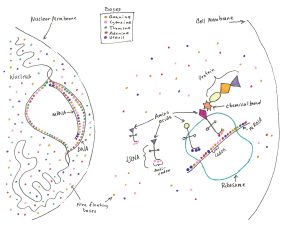
Translation
1) The mRNA goes into the ribosomes, where tRNA (translation RNA) reads the mRNA.
2) As the tRNA reads the mRNA, it attaches complementary amino acids to the newly synthesized amino acid chain (AKA the growing protein chain).
Important note: The important thing to remember about protein synthesis is that when a protein is synthesized, sometimes accidents or mistakes happen. This is where some of the variation in protein synthesis comes from. Additionally, remember the possible mistakes in DNA replication? If the original DNA strand is changed so that a gene is altered, that can affect protein synthesis as well.
This video has fantastic digital animations illustrating DNA replication and protein synthesis.
Cell replication
In order to make more cells, we not only have to have replicated DNA, we have to replicate the rest of the cell as well in order to physically divide that replicated DNA. For body cells (AKA somatic cells), this process is called mitosis. For sex cells (AKA sperm and eggs), this process is called meiosis. But first, a little bit about DNA and chromosomes.
Chromosomes

Most of the time, DNA in cells is in loosely arranged, dispersed strands (think of a pile of cooked spaghetti). When DNA is like this, it’s called chromatin. However, during cell replication DNA condenses into structures called chromosomes.
Each chromosome is made of (the numbers reference the illustration to the right): 1) two “sister” chromatids, 2) a centromere, which is a highly condensed area on the chromosome, 3) the “short arm” of the chromatid (also called the p arm), 4) the “long arm” of the chromatid (also called the q arm), and the 5) telomere, which is the end of a chromosome and is involved in both replication and chromosomal stability. In this diagram, the different colors represent genes on the chromosome.
Each somatic cell (sex cells are different) has the same number of chromosomes. This number is consistent within species, but often differs between species. The number of chromosomes in each body cell is called the diploid number. Sex cells have half as many chromosomes as do somatic cells. This number is called the haploid number.
Most species have two copies of each chromosome in each somatic cell. The member-chromosomes of each pair are called homologous chromosomes.
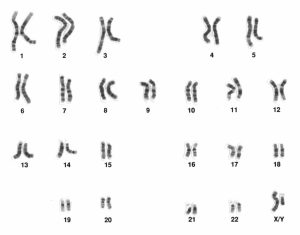
The graphic above is a karyotype, which is an image of the full diploid complement of chromosomes from an individual. Above each number is each pair of homologous chromosomes. This is from a human male, who typically has 23 pairs of chromosomes in each somatic cell, for a diploid total of 46 chromosomes. For humans, sex cells normally have 23 chromosomes.
Genes are found on each chromosome at a particular location called a locus (sing.) or loci (pl.). Different versions of the same gene are called alleles. If someone has the same version of a gene (the same alleles) on both of their homologous chromosomes, they have homozygous alleles. If, however, someone has two different versions of a gene (different alleles) on their homologous chromosomes, they have heterozygous alleles. For example, if on this person’s chromosome 9 pair they have one allele for blood type A and one allele for blood type B, we would say that they are heterozygous for blood type (AB). If they have two alleles for blood type O, we would say that they are homozygous for blood type (OO).
Explore human chromosomes.
Mitosis
Somatic cells (AKA body cells) are replicated via the process of mitosis. This is where all new body cells come from. So, when you scratch yourself on something, mitosis is what makes new skin cells for healing that scratch.
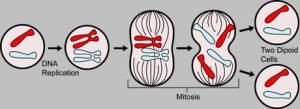
Mitosis has 4 phases (note that DNA has already replicated when mitosis starts):
1) Prophase:
- the nuclear envelope disappears
- chromatin condenses and forms chromosomes
- the chromosomes move toward the equator of the cell
2) Metaphase
- the chromosomes are lined up along the equator of the cell
3) Anaphase
- the sister chromatids split up and move toward the opposite ends of the cell
4) Telophase
- the cytoplasm divides between the two cells
- the chromosomes turn back into chromatin
The result is two identical “daughter” somatic cells, each of which contains one chromosome from the “parent” cell and one replicated chromosome.
Here’s a video that illustrates the process: mitosis in action.
Meiosis
Sex cells (eggs and sperm) are replicated via the process of meiosis. For human females this process occurs and is completed before birth, but for males meiosis begins at puberty and continues throughout their lifespans. Meiosis is more complicated than mitosis in that it has two “cycles”.

1) Prophase 1
- chromatin condenses and forms chromosomes
- DNA is exchanged between homologous chromosomes. This is called homologous recombination. Recombination is an important source of genetic variation.
- the chromosomes start to line up at the equator of the cell
2) Metaphase 1
- the chromosomes are lined up along the equator of the cell
3) Anaphase 1
- the homologous chromosomes move toward the opposite ends of the cell
4) Telophase 1
- the cytoplasm divides between the two cells
- the chromosomes uncoil and turn back into chromatin
5) Prophase 2
- nuclear envelope disappears
- chromatin condenses into chromosomes
- the chromosomes start to line up at the equator of the cell
6) Metaphase 2
- the chromosomes are lined up along the equator of the cell
7) Anaphase 2
- the sister chromatids split apart at the centromeres and move toward the opposite ends of the cell
8) Telophase 2
- chromosomes turn back into chromatin
- the cytoplasm divides between the two cells
- Here’s a video that illustrates the process: meiosis in action
Errors during mitosis and meiosis
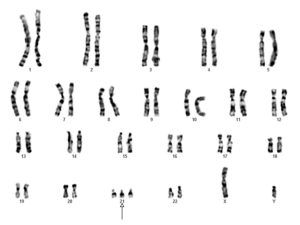
The chromosomes separate during meiosis 1 and the sister chromatids separate in meiosis 2 and mitosis. If this proceeds normally, it’s called disjunction. If the separations occur abnormally, it’s called nondisjunction. What results is an abnormal number of chromosomes (either too many, AKA trisomy OR too few, AKA monosomy).
Some of the more familiar nondisjunctions include:
- Down Syndrome – trisomy of chromosome 21 (a karyotype of this is to the right)
- Klinefelter Syndrome – extra X chromosomes in males (ex. XXY)
- Turner Syndrome – lacking an X chromosome in females (XO)
Test Yourself
Can you answer the following questions? If not, reread the chapter.
- What are cells and what is their function?
- What are the differences between prokaryotic and eukaryotic cells?
- What are the structures of the animal cell?
- What is DNA and what are its functions?
- What are nucleotides?
- What is protein synthesis and what is its process?
- What is the definition of a chromosome and what is its function?
- What are homologous chromosomes?
- What are the differences between mitosis and meiosis?
Cite this page
APA Style: Field, M. 2022. Cell biology and molecular genetics. In T. M. Saneda & M. Field, Biological Anthropology: a brief introduction. Cascadia College Pressbooks.
Chicago Style: Field, Michelle. 2022. “Cell Biology and Molecular Genetics.” In Biological Anthropology: A Brief Introduction, 3rd. Bothell, WA: Cascadia College Pressbooks.
CSE Style: Field M. 2010. Cell biology and molecular genetics. In: Biological Anthropology: a brief introduction, 3rd ed. Bothell (WA): Cascadia College Pressbooks. [modified 2022; accessed 2022 Dec 5]. https://openwa.pressbooks.pub/anth205bioanth/chapter/cellbio/.

